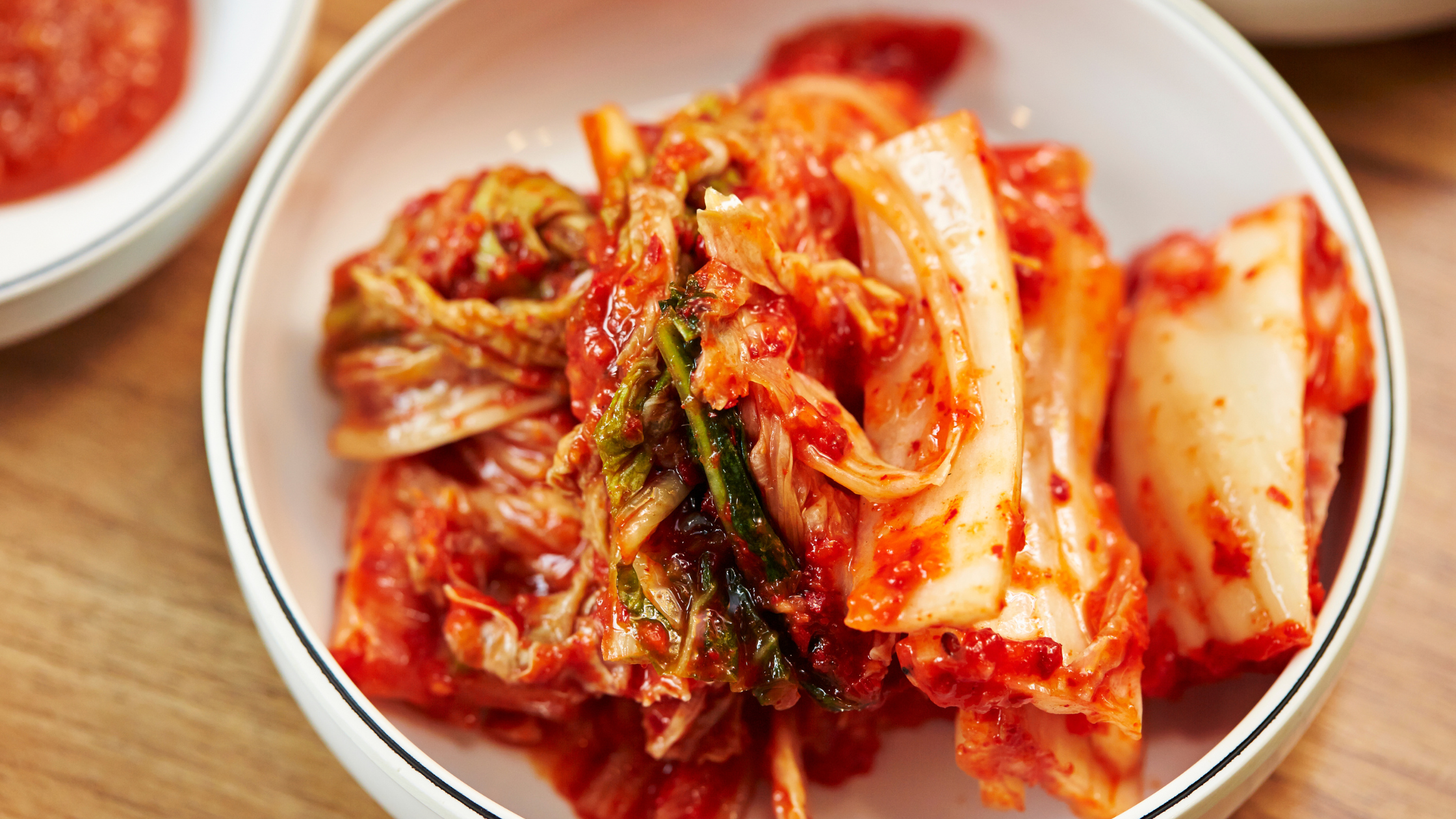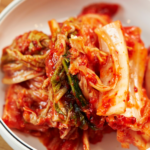What is Kimchi?
Kimchi is a staple dish in Korean cuisine made of salted and fermented vegetables. The name kimchi encompasses any vegetable that is fermented in the korean style.
Many people are familiar with the traditional napa cabbage kimchi also known as baechu kimchi. It usually includes napa cabbage, radish, and gochugaru (korean chili pepper powder) with a few additional spices and vegetables. In Korea, kimchi is traditionally eaten as a side to every meal or even incorporated into the main dish. To be truthful, it took me a minute to even figure out some of these ingredients.
Health Benefits
In addition to being a delicious accompaniment to meals, kimchi has numerous health benefits. It is known to improve digestive health because it is chock-full of probiotics. Kimchi also contains many vitamins and antioxidants including folate, beta-carotene, choline, potassium, vitamin A, vitamin C, and vitamin K, and calcium.
All the probiotics from fermentation and lots of garlic in the kimchi works wonders!
How to Make Your Own Kimchi
Kimchi is surprisingly easy to make at home. Our family makes traditional napa cabbage kimchi, with a little bit of variation in the vegetables based on what we have available in the garden. Traditionally, seafood is added but I’ve never been brave enough to try it in my kimchi.
The recipe below uses napa cabbage, daikon radish, garlic, ginger, gochugaru, carrots, scallions or chinese chives, and a yellow onion.
These vegetables are all in season in fall with the exception of the yellow onion and garlic, which are cured and stored from a summer harvest.
Gochugaru (korean chili pepper powder) may be tricky to find locally. You can check asian markets or the ethnic foods section at your grocery store. It is much easier to find and obtain online.
If you want authentic kimchi flavor the gochugaru is a must-have! I personally think it is worth the effort to buy or grow. But if you would like to try a substitute, cayenne pepper flakes or chipotle powder can be used as an alternative. Keep in mind the results will be quite different because cayenne peppers are spicier and chipotle peppers are smokier than gochugaru.
Supplies
- 2 Gallon Humble House Sauerkraut fermenting crock
- 2 Gallon Ohio Stoneware Fermentation Crock Weights
- Cabbage Stomper
- Mason Jars for storing
Kimchi
Equipment
- Fermenting Crock
- weights
- Cabbage stomper
Ingredients
For the Brine:
- 2 gallons unchlorinated water
- 2 cups unrefined sea salt
For the Kimchi
- 10 lbs napa cabbage
- 2 cups daikon radish, shredded
- 2 cups shredded carrots
- 18 cloves cloves garlic, peeled and minced
- 1 small yellow onion, sliced very thin
- 1 cup green onions, sliced into ½ inch pieces
- 1/4 cup ginger, peeled and minced
- 1 tbsp organic cane sugar
- 1 cup gochugaru (korean chili powder)
- 1/4 cup tapioca starch tapioca starch is a thickener. You can add it if you like the kimchi liquid to not be so runny.
Instructions
- Prepare the brine by mixing the water and sea salt together in a very large mixing bowl until the salt dissolves. You can also split the brine into two bowls using 1 gallon of water and 1 cup of salt per bowl if your bowl isn’t big enough.
- Wash the cabbage in cool water.
- Remove and reserve a few of the large outermost leaves of the cabbage for later.
- With the remaining cabbage, slice the cabbages into quarters and place into the brine.
- Add a plate over the top of the cabbages. Then add your weights over that to keep the cabbage submerged in the brine.
- Let the cabbage soak in the brine for 4-6 hours.
- After soaking, reserve 3 cups of brine and set aside. (Don’t forget this step!)
- Then drain the cabbage in a colander.
- Chop cabbage into bite size pieces and place in a very large bowl.
- Add radishes, carrots, garlic, onion, chinese chives, ginger, gochugaru, and sugar. If you are adding the optional sweet rice flour, stir it in at this point. Mix well.
- Transfer the mixed vegetables and spices into your fermentation crock a little at a time, using the stomper to firmly push down the vegetables, Packing as tightly as possible.
- Place your weights on top.
- Add the reserved brine but ONLY ENOUGH to cover all the vegetables by a little bit, it could be anywhere from a 1/2 cup to 3 cups depending on the freshness of your vegetables. Additional liquid will release from the vegetables during the first few days of the ferment. Adding too much brine will result in a kimchi that is too salty and watered down.
- Cover the crock with a plate, lid, or towel, and let ferment in a cool, dark area for 7-28 days. You can begin taste testing at 7 days. The longer you ferment the more pickled the flavor will become.
- When the ferment is finished, remove kimchi from the crock and place in individual mason jars with lids. Recipe yield is approximately 5 quarts of kimchi.
- Kimchi should be stored in the refrigerator when the ferment is finished. It can also be stored in a root cellar as long as it hovers between 32 and 40ºF. Under these conditions, kimchi will stay fresh for nine months to one year.


